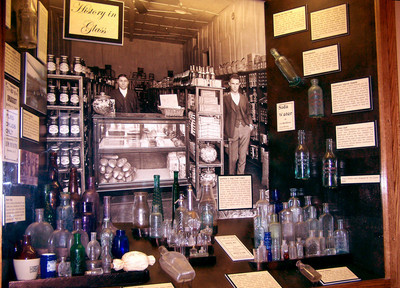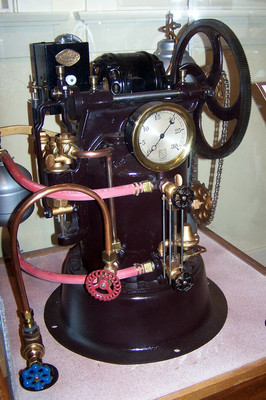Pretty Lively for a Ghost Town
My first "visit" to Jerome, Ariz., was a midnight drive through town in June 1959. My sister, Patricia, her husband, Leroy, and I were on the last leg of a road trip from Clarksville, Tenn., to home in the suburbs of Los Angeles.
This was before Interstate highways shrank the West, and it seemed more expedient to swing south at Flagstaff, Ariz., and go through Jerome, Prescott, and Blythe, rather than stay on Route 66 into the California cities of Needles, Barstow and San Bernardino.
The moon was near full as we drove south on Highway 89 toward Jerome. We could see it on the hillside, and we wondered aloud if it was a ghost town, or just ghostly looking in the lunar light. As Leroy nursed his 1947 Chevy up the narrow, winding road leading into and through Jerome, we concluded this was a ghost town, or nearly so. Its buildings were dilapidated, many of them obviously having shifted on their foundations, others boarded up, and not a light or human in sight.
There were, perhaps, one or two cars parked in what was apparently the main street and the only level road in town. We drove through, talking and laughing about how Jerome wouldn't even exist in another 10 years or so.
Well, we were right and we were wrong. We were right that Jerome was pretty much a ghost town. It had few residents, many of its buildings were sliding down the town's hillside, and more were crumbling in the Arizona sunshine. We were wrong, however, in predicting that Jerome's only future would be a roadside historical plaque.
I returned to Jerome a few months ago, for the first time since that creepy midnight tour. This time it was daylight, but even if it had been night, I would have realized this wasn't the same Jerome I'd passed through nearly 50 years ago. Instead of a dying, blighted community, I found a town that is thriving, a lively piece of Arizona history, and a place that attracts thousands of visitors annually.
What happened? What saved the dying town? And what makes it worth visiting today?
To understand what's happening now, look at what happened before.
Al Sieber, more famous as the archetypical U.S. Army scout of the Indian wars, also is credited with making the first mining claims here to be recognized by white man's law. He based his own 1876 claims on what he recognized to be rudimentary workings by American Indians. A few more miners came to the area and filed claims, too. Jerome wasn't far behind.
Canvas and board hovels began popping up on the hillsides, and the community was named Jerome, in honor of one of the principal investors, Eugene Jerome, of New York. Jerome, a cousin of Winston Churchill, never visited the town named for him.
In 1888, entrepreneur William A. Clark bought up claims, built a railroad to exploit them fully, and in the late 1890s and early 1900s, his United Verde Co. became the largest copper mine in the U.S. (Less than two decades later, the same man would build the railroad that brought Las Vegas into existence, and Nevada's most populous county is named for him.)
Jerome incorporated in 1889, and as it flourished, it became a real town with real brick-and-mortar and wood buildings. Many of them were and are precariously situated on the 30-degree slope of Cleopatra Hill. And a number of the town's current buildings were built in the 1890s and early 1900s.
In 1912, "Rawhide Jimmy" Douglas came to Jerome and bought the claim to the Little Daisy mine. He struck it rich when his crews found huge copper ore deposits just as copper prices soared in the threatening shadow of World War I. Jerome's population topped out at 15,000 early in the 20th century. It was, for a time, the state's fourth largest town.
By 1929, Jerome had two major copper mines--the United Verde Co. and the Little Daisy, each pumping out tons of copper ore. But by 1930, Jerome was in the throes of the Great Depression. Copper prices fell, and in 1935, United Verde Co. sold its mining interests to Phelps Dodge. By 1938, the Little Daisy closed down. In 1953, all copper mining there ended when Phelps Dodge closed its Jerome operation.
Businesses and residents soon departed, too. By 1960 there were between 50 and 100 souls -- perhaps "survivors" is a better word -- still hanging on in Jerome.
Those stubborn folks, however, wouldn't let Jerome die. They protected its historic buildings from vandals and squatters and somehow kept the town going.
In the mid-1960s, two things happened that helped turn the town into a thriving tourist and artist community. The Douglas Mansion, probably the most impressive building in Jerome, became an Arizona State Museum in 1965. And in 1967, the federal government declared Jerome a National Historical District. Funds became available to preserve Jerome, which attracted tourists, history buffs and those with a hankering for living in an out-of-the-ordinary place.
Today, Jerome has a population of about 450. In the mix are artists, crafts people, musicians, writers, hermits, bed-and-breakfast owners, museum caretakers, gift shop proprietors and others craving the serenity available in Jerome.
Jerome looks a lot like it did a century ago and has been described by some as a photographer's paradise. Many of its buildings have been restored, and more restoration is planned. Gravity has helped a number of buildings slide down the steep grade of Cleopatra Hill. But collapsed and dilapidated buildings make for interesting viewing and photo opportunities.
Almost all mining towns of the 19th and early 20th centuries had a crib district, and Jerome was no exception. Jerome's historical, but infamous prostitution row, can be found in a back alley across the street from the English Kitchen.
In 1916, just above the Little Daisy Mine, Rawhide Jimmy built his residence. A sprawling two-story structure, the Douglas Mansion is impressive even today, and was more so when built. It covers about 19,000 square feet, and is now a museum dedicated to the history of Jerome as well as the Douglas family. There are numerous exhibits -- photographs, artifacts, minerals and mining equipment.
Interested parties should begin their visit in Jerome at the Douglas Museum. There's a video presentation about the history of the town and the museum, which is well worth the 20 minutes or so it takes to view it. By watching it before exploring the town, you'll have a better appreciation of Jerome. The museum also has a three-dimensional diorama of Jerome and the mines below it.
The Douglas Mansion was the family's home, but also it was a hotel for mining officials, investors and Rawhide Jimmy's cronies. The house had numerous bedrooms, a wine cellar, billiards room, a marble shower, steam heating and even a central vacuuming system. Douglas was especially proud of the fact that his huge home was constructed of adobe bricks made on his property.
Visible from the museum, and to the south, are the remains of the Little Daisy Hotel. Douglas built it in 1918 as a residence for his unmarried miners, and it was used for 20 years. At first glance, it appears to be a complete building, but it isn't. Over the years, it was stripped of useful materials. In town, at the east end of Main Street, you can look down on the building. Its roof is gone, and it's plain that what remains is merely a facade.
The United Verde Co. had its own hospital to care for miners and their families. It is now the Jerome Grand Hotel and the highest building on the hill overlooking Jerome. From it, you can view the town and the expanse of the Verde Valley. It's easy to spot the hotel from the Douglas Museum. Just look up and to the west for the yellow building with red awnings.
Downtown Jerome has its share of antique stores, galleries, specialty shops and historic buildings. Main Street is prime territory for such places, but on Hull Street, Jerome Avenue and Clark Street you'll find numerous out-of-the-ordinary establishments.
Many of the historic buildings, such as the Hotel Connor, have brass plaques that give a brief history of the building and its significance to Jerome. The Connor, its plaque reveals, was built in 1898 from brick and native stone. It was "devastated by fire" a couple of times, but David Connor always rebuilt it. The building's upper floor is still used as a hotel. In its heyday, it was the hotel "second to none in the Southwest."
On Main Street, shops such as Made in Jerome Pottery, which sells handcrafted wares made from native clay, stand out. Nearby, there's Nellie Bly II, specializing in unusual gemstones and individually designed jewelry. And Victorian Treasures has a diverse collection of antiques and collectibles.
On Clark Street is The Sage Post, which offers coffee, books, cigars and antiques. And on Jerome Avenue is Mooey Christmas, a specialty shop with distinctly bovine slant. There are cow-influenced seasonal decorations including hand-blown ornaments and hand-carved figurines.
As my recent visit ended, I recalled the first time I was in Jerome. I realized it still feels like a ghost town, but it offers visitors so much more today than it did nearly a half-century ago -- history, shopping, hotels and excellent eateries. And I can say something about it today that I couldn't say in 1959 -- it's worth a visit.
Contact Richard Bauman at Richard@ richardbauman.com.
GETTING THERE
Location: Jerome, Ariz., about 270 miles southeast of Las Vegas.
Directions: From Las Vegas, take U.S. Highway 93 south 26 miles to Boulder City, turn left to stay on U.S. 93 and bypass the business district, continue 78 miles to Kingman, Ariz., and merge onto Interstate 40 east. Take I-40 east for approximately 96 miles, to the Ash Fork/Prescott exit (No. 146). Turn right onto Arizona state Route 89 for 43.5 miles, to Pioneer Parkway. Turn left onto Pioneer Parkway, which is Arizona 89-ALT, and drive approximately 24 miles and into the heart of Jerome.
Visitor Information: Jerome Chamber of Commerce, (928) 634-2900, www.jeromechamber.com; Jerome Historical Society, (928) 634-1066, www. jeromehistoricalsociety.org.
Lodging: The Jerome Grand Hotel, (928) 634-8200, www.jeromegrandhotel. net; The Connor Hotel (800) 523-3554, (928) 634-5006. www.connorhotel.com; The Cottage Inn, (928) 634-0701, (928) 649-6759, www. cottageinnjerome.com.
Dining: Belgian Jennie's Bordello, Bistro, and Pizzeria, 412 Main St. (928) 639-3141, www.belgianjennies.com; Mile High Grill, 309 Main St, (928) 634-5094, www. jeromemilehighinn.com; Jerome Palace/Haunted Hamburger, Jerome Avenue (928) 634-0554.
Nearby Points of interest: Northeast of Jerome are Sedona, Ariz., and Oak Creek Canyon, 30 miles; Montezuma Castle National Monument, an ancient cliff dwelling, 27 miles; and Tuzigoot National Monument, the ruins of an ancient pueblo, eight miles. Maps and directions are available from the Jerome Chamber of Commerce.




















